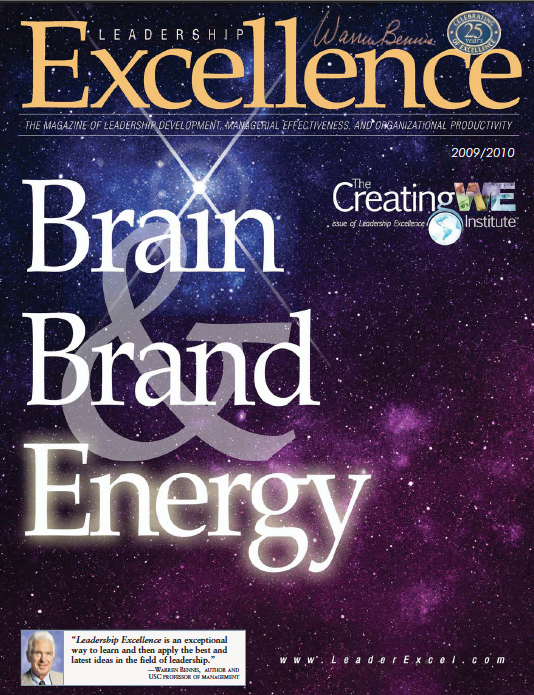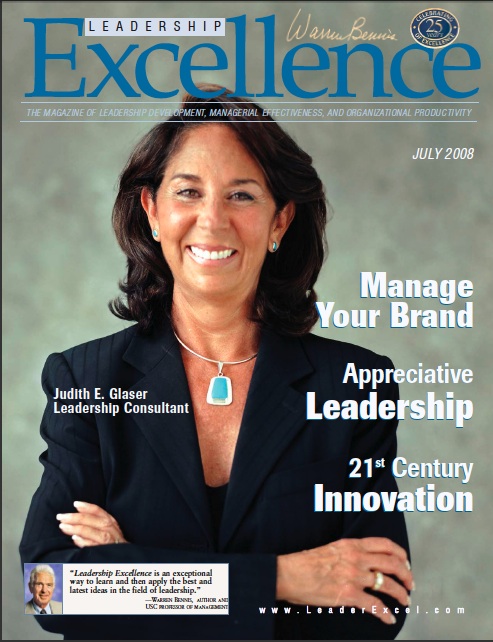By Judith E. Glaser | Leadership Excellence
Published April 2007
Go from dictating to developing.
Environments where employees work by the book—laden with rules and regulations about what can’t be done—are not attractive to people full of spirit seeking to make their mark on the world. In such places, leaders wonder why they have a stodgy culture, or why people call in sick all the time, or why people don’t enjoy their work.
On the other hand, leaders who focus on developing rather than dictating to people inspire them toward greater self-expression and encourage their leadership voice. In companies where people development flourishes, we see employees valued for their contributions, sharing their voice, taking risks, and meeting audacious goals. There is a great sense of shared ownership, accountability, and accomplishment. Such workplaces allow the human spirit to soar.
Five Actions
Here are five actions any leader can take to develop a workplace where all members contribute:
1. Celebrate speaking up. Celebrate speaking up as a cultural norm. Ask questions to draw people out. Make it easy to speak up, express a point of view, celebrate success, and push back on authority in a constructive way. Support an open culture by acknowledging you value it whenever you can. When someone has done something great, public recognition from a boss can be as important or more important, than a monetary reward.
2. Make conversation easy. Candor and “tough” conversations solve tough problems. Make open dialogue a way of life. Provide coaching from top to bottom about how to have “difficult conversations.” Honest talk is not mean talk—it’s about having candor with others. Without it, companies can’t work together strategically. Candor provides feedback vital to creating mutual success. Once candor skills become clearly embedded in conversations, it just becomes “the way we do things around here.”
3. Coach with developmental questions. Developmental coaching is not based on “constructive criticism” but rather on developing “constructive foresight,” which looks to the future and focuses on what people can do differently to create better results. To develop foresight, ask: What have you learned from this challenge? What would you do differently in the future if you could do it again? How would you approach this if you had full authority? What would you try differently to get a different result? How else can I help you in the future?
 4. Ask questions and wait for answers. In most meetings, declarative statements outweigh questions by 85 percent to 15 percent. Leaders who focus on learning how to craft great questions gain great benefits. They help people to think about issues in new ways, engage people in positively challenging each other’s thinking, and create a culture of ownership for the outcomes. Learning to be comfortable living with questions creates a culture where people can think out loud, make new connections, and think outside the lines about how they might approach a challenge. Rather than telling employees how you would solve their challenge, you enable their wisdom and insight to emerge. The result is a healthy environment that develops talent.
4. Ask questions and wait for answers. In most meetings, declarative statements outweigh questions by 85 percent to 15 percent. Leaders who focus on learning how to craft great questions gain great benefits. They help people to think about issues in new ways, engage people in positively challenging each other’s thinking, and create a culture of ownership for the outcomes. Learning to be comfortable living with questions creates a culture where people can think out loud, make new connections, and think outside the lines about how they might approach a challenge. Rather than telling employees how you would solve their challenge, you enable their wisdom and insight to emerge. The result is a healthy environment that develops talent.
5. Ask yourself some questions too. To perpetuate growth of both your people and your organization, you need to ask yourself some key questions every day: How do I shift from a telling leader to an asking one? What actions can I take to support a mentoring and coaching culture? How can I grow talent and the business at the same time? How can I make development part of everyone’s agenda?
Twenty Questions
The best leaders focus more on developing than dictating. Their priority is bringing out the potential in others, which inspires commitment and ownership. They develop people by creating a culture where every individual makes a genuine contribution.
Here are 20 questions that indicate the attitude of a leader who develops others. Consider which questions you could ask more often. Use them to help you create an energetic workplace where people will thrive and reach their potential.
- I’m not the expert in these things. What do you think?
- I value the differences you bring to this. What is your perspective?
- What can you add to these ideas?
- What jobs would you like to learn?
- Think big. What would be your greatest aspiration for the project?
- What parts of my job would you like to learn?
- I applaud you for encouraging people. What did you say that excited them?
- I want you to stretch yourself on this project. What would help you push outside your comfort zone?
- Here are our challenges. What ideas do you have on how to tackle them?
- Thank you for your effort on that project! What was your biggest insight?
- What have you learned from this?
- Here are my ideas for your development. Which ones excite you most?
- What would you like to do next to advance your leadership?
- What ideas for your development have I missed—something you want to do and would like my support with?
- We haven’t talk about your progress on your project. I’d love to hear your insights.
- I’d love to know what criterion you used to make your decision.
- I trust your judgment on this. It was a tough decision to make. I’d love to see it from your perspective.
- How can I help you advance?
- Where can I do less telling and more asking?
- What are your ideas on how we can grow the business and talent?
When your people feel challenged and inspired by you, they grow into their greatness. They can then inspire growth in others. Leaders who mentor and coach their people create other mentors and coaches. They coach their company to greatness by drawing out the best in others.




